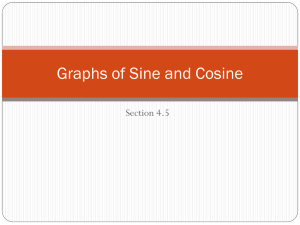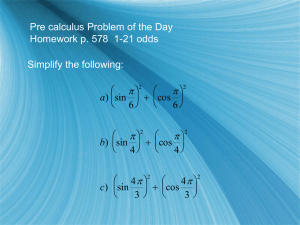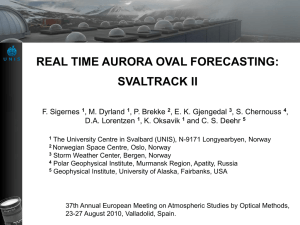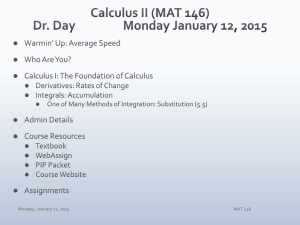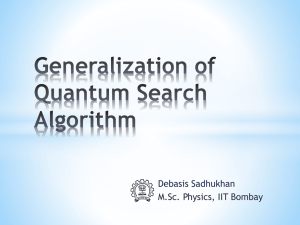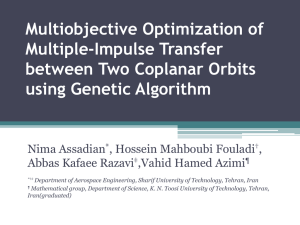Lecture 1: Elementary quantum algorithms
advertisement
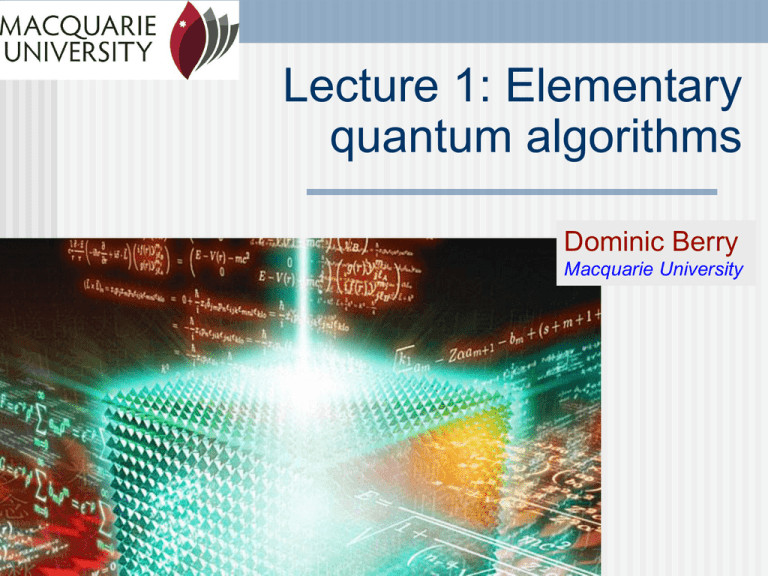
Lecture 1: Elementary
quantum algorithms
Dominic Berry
Macquarie University
Quantum simulator
All classical computers work in fundamentally the same
way.
Quantum systems are fundamentally different. The size
of the problem goes up exponentially in the size of the
system, making them hard to simulate.
1982
Richard Feynman
In 1982 this led Feynman to propose quantum
computers. A quantum system should be able to
efficiently simulate another quantum system.
Efficiently means that the resources
used (time and size of the system)
should scale at most polynomially in
the size of the system to be simulated.
Polynomially means as 𝑥, 𝑥 2 , 𝑥 3 , etc.
Universal quantum computer
A classical computer uses bits, e.g.
001100010010011110100001101101110011
Quantum computers replace this with a quantum state
001100010010011110100001101101110011
Each digit is a two-level quantum system – a qubit.
1985
David Deutsch
Quantum computers can be in superpositions of these states
𝑁
|𝜓⟩ =
𝜓𝑥 |𝑥⟩
𝑥=1
Represent the state as a vector:
𝜓1
𝜓2
𝜓 ≡ 𝜓3
⋮
𝜓𝑁
Universal quantum computer
Operations on the state can be represented as matrices:
𝑈11 ⋯ 𝑈1𝑁
⋱
⋮
𝑈≡ ⋮
𝑈𝑁1 ⋯ 𝑈𝑁𝑁
The allowed operations on this state are unitary matrices. These satisfy
𝑈†𝑈 = 𝕀
The † indicates the Hermitian conjugate – the transpose and complex
conjugate of the matrix.
Any allowed operation is reversible. Using 𝑈 † on 𝑈|𝜓⟩ will restore the
state |𝜓⟩.
A special case is permutation matrices – a permutation matrix only
changes one computational basis state to another.
Examples of permutations
1.
The NOT operation, also called an 𝑋, acts on a single qubit
0 1
𝑋≡
1 0
It takes |0⟩ to |1⟩, and vice versa.
2.
The controlled NOT acts on two qubits. It performs an 𝑋 on the target
qubit if the control qubit is in the state |1⟩. Otherwise it does nothing.
1
0
0
0
3.
0
1
0
0
0
0
0
1
0
0
1
0
The Toffoli gate is a NOT controlled by two qubits. It performs an 𝑋
only if both controls are in the state |1⟩.
1 0 0 0 0 0 0 0
0
0
0
0
0
0
0
1
0
0
0
0
0
0
0
1
0
0
0
0
0
0
0
1
0
0
0
0
0
0
0
1
0
0
0
0
0
0
0
1
0
0
0
0
0
0
0
0
1
0
0
0
0
0
1
0
Turning classical into quantum
The NAND gate is universal for classical circuits and acts as below.
𝐴
𝐵
𝑄
𝑨
𝑩
𝑸
0
0
1
0
1
1
1
0
1
1
1
0
We can perform the same operation using a Toffoli gate.
|𝐴⟩
|𝐴⟩
|𝐵⟩
|𝐵⟩
|1⟩
|𝑄⟩
We can convert any classical algorithm into a quantum algorithm,
replacing the NAND gates with Toffolis, and keeping the extra qubits.
Turning classical into quantum
Any function we could calculate on a classical computer we could also
compute on a quantum computer, with the addition of some extra
“garbage” registers.
𝑥 0 ↦ 𝑓 𝑥 |extra data(𝑥)⟩
This can be turned into a computation that does this:
𝑈𝑓 𝑥 0 = 𝑥 |𝑓 𝑥 ⟩
Method:
Add an ancilla, and perform the program as above to give
𝑓 𝑥 |0⟩ extra data(𝑥) .
Copy the output of the function into the extra ancilla, to give
𝑓 𝑥 |𝑓(𝑥)⟩ extra data(𝑥) .
Invert the program above, giving 𝑥 |𝑓 𝑥 ⟩ 0 .
1.
2.
3.
For ancillas that are not initially zeroed, we can just perform the XOR.
𝑈𝑓 𝑥 𝑏 = 𝑥 |𝑏 ⊕ 𝑓 𝑥 ⟩
Part of the story: Superposition
Now what if we start the state in a
superposition?
1
2𝑛
2𝑛
𝑥 |0⟩ ↦
𝑥=1
1
2𝑛
2𝑛
𝑥 |𝑓(𝑥)⟩
𝑥=1
For 𝑛 qubits, we have evaluated an
exponential number of different values of
the function.
But if we measure it, we only ever find one value of the function!
The other part: Interference
We can’t just calculate many values
of a function, we need some way to
interfere them to obtain some global
property of the function.
Just measuring Schrödinger’s cat
would never show it in a
superposition.
If we could do a Hadamard on
Schrödinger’s cat, we would turn
1.
( live + |dead⟩)/ 2 to live ,
and
2.
( live − |dead⟩)/ 2 to dead
We need non-permutation gates:
The Hadamard gate has a matrix
representation
1 1 1
𝐻≡
2 1 −1
0 ↔ (|0⟩ + |1⟩)/ 2
1 ↔ (|0⟩ − |1⟩)/ 2
showing we have superposition.
The other part: Interference
We can’t just calculate many values of a function, we need some way to
interfere them to obtain some global property of the function.
Universal sets of gates:
1.
The Hadamard gate
1 1
𝐻≡
2 1
1
−1
together with the Toffoli gate is universal for real unitaries.
2.
The 𝜋/8 or 𝑇 gate
1
0
0 𝑒 𝑖𝜋/4
together with the Hadamard and CNOT is universal.
𝑇≡
The Deutsch algorithm
Problem: Given a function 𝑓(𝑥) mapping bits to bits,
determine if it is one-to-one [i.e. 𝑓 0 ≠ 𝑓(1)].
Classically we need to evaluate both 𝑓(0) and 𝑓(1).
Quantum algorithm:
1.
Start with
David Deutsch
0 |1⟩
2.
3.
4.
Perform a Hadamard on both qubits to give
1
0 { 0 − 1 } + 1 { 0 − |1⟩}
2
Apply the gate mapping 𝑥 |𝑏⟩ ↦ 𝑥 |𝑏 ⊕ 𝑓 𝑥 ⟩ to give
1
0 { 𝑓 0 − 1 ⊕ 𝑓 0 } + 1 { 𝑓 1 − |1 ⊕ 𝑓(1)⟩}
2
Apply Hadamard on qubit 2 to give
1
0 { −1 𝑓 0 } + 1 { −1
2
1985
𝑓 1
} |1⟩
The Deutsch algorithm
1.
1985
Start with
0 |1⟩
2.
Perform a Hadamard on both qubits to give
1
0 { 0 − 1 } + 1 { 0 − |1⟩}
2
3.
Apply the gate mapping 𝑥 |𝑏⟩ ↦ 𝑥 |𝑏 ⊕ 𝑓 𝑥 ⟩ to give
David Deutsch
1
0 { 𝑓 0 − 1 ⊕ 𝑓 0 } + 1 { 𝑓 1 − |1 ⊕ 𝑓 (1)⟩}
2
4.
Apply Hadamard on qubit 2 to give
1
0 { −1 𝑓 0 } + 1 { −1If𝑓𝑓1 0} |1⟩
If 𝑓(0) = 𝑓(1) then we
≠ 𝑓(1) then we
2
only get this part
only get this part
5.
Apply
Hadamard
on
qubit
1
to
give
qubit 1 is in state 0 .
qubit 1 is in state 1 .
1
0 + 1
−1 𝑓 0 + { 0 − |1⟩} −1 𝑓 1 1
2
6.
Rearranging gives
1
0 −1 𝑓 0 + −1 𝑓 1 + 1 −1 𝑓 0 − −1 𝑓 1 1
2
The Deutsch algorithm
Problem: Given a function 𝑓(𝑥) mapping 1 bit to 1 bit
𝑓 𝑥 : {0,1} → {0,1}, determine if it is either constant or
balanced.
Classically we need to evaluate both 𝑓(0) and 𝑓(1).
1985
David Deutsch
Deutsch quantum algorithm gives result with one function
evaluation.
Quantum algorithm has two crucial steps:
Calculate the function on both input values simultaneously.
Interfere the result.
1.
2.
The Deutsch algorithm
Problem: Given a function 𝑓(𝑥) mapping 1 bit to 1 bit
𝑓 𝑥 : {0,1} → {0,1}, determine if it is either constant or
balanced.
Classically we need to evaluate both 𝑓(0) and 𝑓(1).
1985
David Deutsch
Deutsch quantum algorithm gives result with one function
evaluation.
Calculate the function
on both input values
simultaneously.
|0⟩
Interfere the result.
𝐻
𝐻
𝑈𝑓
|1⟩
𝐻
𝐻
measurement
The Deutsch-Jozsa algorithm
1992
Problem: Given a function 𝑓(𝑥) mapping 𝑛 bits to 1 bit
𝑓 𝑥 : 0,1 𝑛 → {0,1}, determine if it is either constant or
balanced. There is a promise that it is either.
Classically we need to evaluate 2𝑛−1 + 1 values of 𝑓(𝑥).
David Deutsch
Deutsch-Jozsa quantum algorithm gives result with one
function evaluation.
0
⊗𝑛
𝐻 ⊗𝑛
𝐻 ⊗𝑛
𝑈𝑓
|1⟩
𝐻
measurement
Richard Jozsa
Phase oracles
We have previously assumed that the unitary for the function acts as
𝑈𝑓 𝑥 𝑏 = 𝑥 |𝑏 ⊕ 𝑓 𝑥 ⟩
In both cases we have needed to turn this into a phase in order to
make the algorithm work, i.e.
1
1
𝑈𝑓 𝑥 (|0⟩ − |1⟩) =
𝑥 (|𝑓(𝑥)⟩ − |1 ⊕ 𝑓(𝑥)⟩)
2
2
1
=
−1 𝑓 𝑥 |𝑥⟩(|0⟩ − |1⟩)
2
Instead we can just take the oracle to have this form:
𝑈𝑓 𝑥 = −1 𝑓 𝑥 |𝑥⟩
The Deutsch-Jozsa algorithm
Deutsch algorithm: start with
2 𝑥=0
2𝑛
−1
𝑓 𝑥
1
2𝑛
1
1
−1
𝑓 𝑥
𝑥=0
−1
𝑦=0
The probability of measuring 𝑦 is
1
4
−1
𝑓 𝑥
−1
𝑦⋅𝑥
𝑥=0
2𝑛 −1
−1
𝑓 𝑥
𝑥
𝑥=0
2𝑛 −1
2𝑛 −1
−1
𝑓 𝑥
𝑥=0
−1
𝑦⋅𝑥 |𝑦⟩
𝑦=0
The probability of measuring 𝑦 is
2
1
𝑥=0
𝑥
Hadamards give
1
2𝑛
𝑦⋅𝑥 |𝑦⟩
2𝑛 −1
The function evaluation yields
𝑥
A Hadamard gives
1
2
1
2 𝑥=0
1
𝑥
The function evaluation yields
1
Deutsch-Jozsa algorithm: start with
1
1
1992
1
22𝑛
2
2𝑛 −1
−1
𝑥=0
𝑓 𝑥
−1
𝑦⋅𝑥
1993
Fourier sampling
Bernstein,
Vazirani
Problem: Given a function 𝑓(𝑥) mapping 1 bit to 1 bit 𝑓 𝑥 : {0,1} → {0,1}
such that 𝑓 𝑥 = 𝑠 ⋅ 𝑥, determine 𝑠.
The function evaluation yields
2𝑛 −1
1
2𝑛
𝑓 𝑥
𝑥
𝑥=0
Hadamards give
1
2𝑛
−1
2𝑛 −1
2𝑛 −1
−1
𝑓 𝑥
𝑥=0
−1
𝑦⋅𝑥 |𝑦⟩
𝑦=0
The probability of measuring 𝑦 is
1
22𝑛
2
2𝑛 −1
−1
𝑥=0
𝑓 𝑥
−1
𝑦⋅𝑥
1
= 2𝑛
2
2
2𝑛 −1
−1
𝑥=0
(𝑦+𝑠)⋅𝑥
= 𝛿𝑦,𝑠
Grover’s search algorithm
1996
Problem: Given a function 𝑓(𝑥) mapping 𝑛 bits to 1 bit
𝑓 𝑥 : 0,1 𝑛 → {0,1}, determine the value of 𝑥 such that
𝑓 𝑥 = 1. We have a promise that the value is unique.
Classically we need to evaluate 𝑂 𝑁 values, 𝑁 = 2𝑛 .
Lov Grover
Grover’s algorithm enables a search with 𝑂
2.
Quantum algorithm has two crucial steps:
Calculate the function on all values simultaneously.
Reflect about the equal superposition state.
These steps are repeated 𝑂
1.
𝑁 times.
𝑁 queries.
Grover’s search algorithm
We start in the state
𝑠 =
1.
2.
1
𝑁
1996
𝑁
𝑥
𝑥=1
We repeat the following ∼ 𝑁 times:
Apply the function calculation 𝑈𝑓 .
Apply the reflection operation 𝑈𝑠 = 2 𝑠 ⟨𝑠| − 𝕀.
The system will be in the state |𝜔⟩ such that 𝑓 𝜔 = 1.
But how do we perform 𝑈𝑠 ?
Lov Grover
Grover’s search algorithm
But how do we perform 𝑈𝑠 ?
First, invert the operation that prepares |𝑠⟩ - just
Hadamards on all qubits.
Then, reflect about |0⟩; i.e. apply 2 0 ⟨0| − 𝕀.
Lastly, repeat the operation that prepares 𝑠 .
|1⟩
𝐻
𝐻
𝐻
𝐻
𝐻
𝐻
𝐻
𝐻
𝐻
𝐻
𝐻
𝐻
𝐻
𝐻
𝐻
𝐻
𝐻
1996
Lov Grover
Grover’s search algorithm
What does 𝑈𝑠 do?
𝑁
𝑈𝑠
𝑥=1
𝑁
2
𝜓𝑥 𝑥 =
𝑁
=
𝑁
𝑥
𝑥=1
𝑁
2
𝑁
𝑁
⟨𝑦|
𝑦=1
𝑁
𝑥
𝑥=1
𝑁
𝜓𝑧 𝑧 −
𝑧=1
𝑁
𝜓𝑦 −
𝑦=1
=
Lov Grover
𝜓𝑥 𝑥
𝑥=1
(2𝜓 − 𝜓𝑥 ) 𝑥
𝑥=1
Each coefficient is reflected about the mean
1
𝜓=
𝑁
𝑁
𝜓𝑦
𝑦=1
𝜓𝑥 𝑥
𝑥=1
𝑁
1996
Grover’s search algorithm
1996
Example: Take 𝑁 = 4, with solution 𝑥 = 3.
We start in the state
𝑠 = 12 (|1⟩ + 2 + 3 + |4⟩)
Apply the function calculation 𝑈𝑓 , giving
1
2(|1⟩ + 2 − 3 + |4⟩)
The mean is
Lov Grover
𝜓 = 14(12 + 12 − 12 + 12) = 14
Grover’s search algorithm
1996
Example: Take 𝑁 = 4, with solution 𝑥 = 3.
We start in the state
𝑠 = 12 (|1⟩ + 2 + 3 + |4⟩)
Apply the function calculation 𝑈𝑓 , giving
1
2(|1⟩ + 2 − 3 + |4⟩)
The mean is
Therefore, when we apply the reflection operation 𝑈𝑠 , we get
1
1
(|1⟩
+
2
+
3
+
|4⟩)
−
(|1⟩ + 2 − 3 + |4⟩) = |3⟩
2
2
Lov Grover
𝜓 = 14(12 + 12 − 12 + 12) = 14
Grover’s search algorithm
1996
Example: Take 𝑁 = 9, with solution 𝑥 = 6.
Reflecting target…
The mean is 7/27.
Lov Grover
Grover’s search algorithm
Example: Take 𝑁 = 9, with solution 𝑥 = 6.
Reflecting target…
The mean is 7/27.
Reflecting about mean…
Reflecting target…
The mean is 17/243.
1996
Lov Grover
Grover’s search algorithm
Example: Take 𝑁 = 9, with solution 𝑥 = 6.
Reflecting target…
The mean is 7/27.
Reflecting about mean…
Reflecting target…
The mean is 17/243.
Reflecting about mean…
Solution with
high probability.
1996
Lov Grover
Grover’s search algorithm
Another way of looking at it: Rotations
Define the ket perpendicular to 𝜔 .
1
′
|𝑠 ⟩ =
|𝑥⟩
𝑁 − 1 𝑥≠𝜔
1996
Lov Grover
Then
𝑠 = cos 𝜙 𝑠′ + sin 𝜙 |𝜔⟩
with sin 𝜙 = 1/ 𝑁.
The operation 𝑈𝑓 reflects 𝜔 and leaves all orthogonal
states unchanged.
𝑈𝑓 = 𝕀 − 2 𝜔 ⟨𝜔|
The action of 𝑈𝑓 on 𝑠′ is
𝑈𝑓 𝑠′ = (𝕀 − 2 𝜔 ⟨𝜔|) 𝑠′ = 𝑠′
Grover’s search algorithm
Another way of looking at it: Rotations
The action of 𝑈𝑓 on 𝑠′ is
𝑈𝑓 𝑠′ = 𝑠′
The action of 𝑈𝑠 on 𝜔 is
𝑈𝑠 𝜔 = (2 𝑠 ⟨𝑠| − 𝕀) 𝜔
=2 𝑠𝜔 𝑠 − 𝜔
= 2 sin 𝜙 𝑠 − 𝜔
Now use
𝑠 = cos 𝜙 𝑠′ + sin 𝜙 |𝜔⟩
This gives
𝑈𝑠 𝜔 = 2 sin 𝜙 cos 𝜙 𝑠′ + sin 𝜙 |𝜔⟩ − 𝜔
= 2 sin 𝜙 cos 𝜙 𝑠 ′ − 1 − 2 sin2 𝜙 𝜔
= sin 2𝜙 𝑠 ′ − cos 2𝜙 |𝜔⟩
1996
Lov Grover
Grover’s search algorithm
Another way of looking at it: Rotations
The action of 𝑈𝑓 on 𝑠′ is
𝑈𝑓 𝑠′ = 𝑠′
The action of 𝑈𝑠 on 𝜔 is
𝑈𝑠 𝜔 = sin 2𝜙 𝑠 ′ − cos 2𝜙 |𝜔⟩
The action of 𝑈𝑠 on 𝑠′ is
𝑈𝑠 𝑠′ = (2 𝑠 ⟨𝑠| − 𝕀) 𝑠′
= 2 𝑠 𝑠′ 𝑠 − 𝑠 ′
= 2 cos 𝜙 𝑠 − |𝑠 ′ ⟩
Now use
𝑠 = cos 𝜙 𝑠′ + sin 𝜙 |𝜔⟩
This gives
𝑈𝑠 𝑠′ = 2 cos 𝜙 cos 𝜙 𝑠′ + sin 𝜙 |𝜔⟩ − 𝑠 ′
= 2 cos 2 𝜙 − 1 s ′ + 2 sin 𝜙 cos 𝜙 𝜔
= cos 2𝜙 𝑠 ′ + sin 2𝜙 |𝜔⟩
1996
Lov Grover
1996
Grover’s search algorithm
Another way of looking at it: Rotations
𝑈𝑓 𝑠′ = 𝑠′
𝑈𝑠 𝜔 = sin 2𝜙 𝑠′ − cos 2𝜙 |𝜔⟩
𝑈𝑠 𝑠′ = cos 2𝜙 𝑠 ′ + sin 2𝜙 |𝜔⟩
Consider a state written as
𝜓 = cos 𝜃 𝑠′ + sin 𝜃 |𝜔⟩
The action of 𝑈𝑓 on 𝜓 is
𝑈𝑓 𝜓 = cos 𝜃 𝑠′ − sin 𝜃 |𝜔⟩
Then applying 𝑈𝑠 gives 𝑈𝑠 𝑈𝑓 𝜓
= cos 𝜃 cos 2𝜙 𝑠 ′ + sin 2𝜙 |𝜔⟩ − sin 𝜃 sin 2𝜙 𝑠′ − cos 2𝜙 |𝜔⟩
= cos 𝜃 cos 2𝜙 − sin 𝜃 sin 2𝜙 𝑠 ′ + cos 𝜃 sin 2𝜙 + sin 𝜃 cos 2𝜙 𝜔
= cos(𝜃 + 2𝜙) 𝑠 ′ + sin(𝜃 + 2𝜙) 𝜔
Lov Grover
Grover’s search algorithm
Another way of looking at it: Rotations
𝑈𝑓 𝑠′ = 𝑠′
𝑈𝑠 𝜔 = sin 2𝜙 𝑠′ − cos 2𝜙 |𝜔⟩
𝑈𝑠 𝑠′ = cos 2𝜙 𝑠 ′ + sin 2𝜙 |𝜔⟩
The Grover iteration gives
𝜓 = cos 𝜃 𝑠′ + sin 𝜃 |𝜔⟩
′
|𝜔⟩ 𝑈𝑠 𝑈𝑓 𝜓 = cos(𝜃 + 2𝜙) 𝑠 + sin(𝜃 + 2𝜙) 𝜔
|𝑠⟩
𝜙
|𝑠′⟩
𝑈𝑓 |𝑠⟩
1996
Lov Grover
Grover’s search algorithm
Another way of looking at it: Rotations
𝑈𝑓 𝑠′ = 𝑠′
𝑈𝑠 𝜔 = sin 2𝜙 𝑠′ − cos 2𝜙 |𝜔⟩
𝑈𝑠 𝑠′ = cos 2𝜙 𝑠 ′ + sin 2𝜙 |𝜔⟩
The Grover iteration gives
𝜓 = cos 𝜃 𝑠′ + sin 𝜃 |𝜔⟩
′
|𝜔⟩ 𝑈𝑠 𝑈𝑓 𝜓 = cos(𝜃 + 2𝜙) 𝑠 + sin(𝜃 + 2𝜙) 𝜔
𝑈𝑠 𝑈𝑓 |𝑠⟩
3𝜙
|𝑠⟩
𝜙
|𝑠′⟩
𝑈𝑓 |𝑠⟩
1996
Lov Grover
Grover’s search algorithm
Another way of looking at it: Rotations
𝑈𝑓 𝑠′ = 𝑠′
𝑈𝑠 𝜔 = sin 2𝜙 𝑠′ − cos 2𝜙 |𝜔⟩
𝑈𝑠 𝑠′ = cos 2𝜙 𝑠 ′ + sin 2𝜙 |𝜔⟩
The Grover iteration gives
𝜓 = cos 𝜃 𝑠′ + sin 𝜃 |𝜔⟩
′
|𝜔⟩ 𝑈𝑠 𝑈𝑓 𝜓 = cos(𝜃 + 2𝜙) 𝑠 + sin(𝜃 + 2𝜙) 𝜔
2
𝑈𝑠 𝑈𝑓 |𝑠⟩
𝑈𝑠 𝑈𝑓 |𝑠⟩
5𝜙
|𝑠⟩
𝜙
|𝑠′⟩
𝑈𝑓 |𝑠⟩
1996
Lov Grover
Grover’s search algorithm
Another way of looking at it: Rotations
𝑈𝑓 𝑠′ = 𝑠′
𝑈𝑠 𝜔 = sin 2𝜙 𝑠′ − cos 2𝜙 |𝜔⟩
𝑈𝑠 𝑠′ = cos 2𝜙 𝑠 ′ + sin 2𝜙 |𝜔⟩
The Grover iteration gives
𝜓 = cos 𝜃 𝑠′ + sin 𝜃 |𝜔⟩
′
|𝜔⟩ 𝑈𝑠 𝑈𝑓 𝜓 = cos(𝜃 + 2𝜙) 𝑠 + sin(𝜃 + 2𝜙) 𝜔
3
𝑈𝑠 𝑈𝑓 |𝑠⟩
2
𝑈𝑠 𝑈𝑓 |𝑠⟩
𝑈𝑠 𝑈𝑓 |𝑠⟩
7𝜙
|𝑠⟩
𝜙
|𝑠′⟩
𝑈𝑓 |𝑠⟩
1996
Lov Grover
Grover’s search algorithm
Another way of looking at it: Rotations
𝑈𝑓 𝑠′ = 𝑠′
𝑈𝑠 𝜔 = sin 2𝜙 𝑠′ − cos 2𝜙 |𝜔⟩
𝑈𝑠 𝑠′ = cos 2𝜙 𝑠 ′ + sin 2𝜙 |𝜔⟩
The Grover iteration gives
𝜓 = cos 𝜃 𝑠′ + sin 𝜃 |𝜔⟩
′
|𝜔⟩ 𝑈𝑠 𝑈𝑓 𝜓 = cos(𝜃 + 2𝜙) 𝑠 + sin(𝜃 + 2𝜙) 𝜔
3
𝑈𝑠 𝑈𝑓 |𝑠⟩
4
𝑈𝑠 𝑈𝑓 |𝑠⟩
2
𝑈𝑠 𝑈𝑓 |𝑠⟩
𝑈𝑠 𝑈𝑓 |𝑠⟩
9𝜙
|𝑠⟩
𝜙
|𝑠′⟩
𝑈𝑓 |𝑠⟩
1996
Lov Grover
Grover’s search algorithm
Another way of looking at it: Rotations
𝑈𝑓 𝑠′ = 𝑠′
𝑈𝑠 𝜔 = sin 2𝜙 𝑠′ − cos 2𝜙 |𝜔⟩
𝑈𝑠 𝑠′ = cos 2𝜙 𝑠 ′ + sin 2𝜙 |𝜔⟩
The Grover iteration gives
𝜓 = cos 𝜃 𝑠′ + sin 𝜃 |𝜔⟩
′
|𝜔⟩ 𝑈𝑠 𝑈𝑓 𝜓 = cos(𝜃 + 2𝜙) 𝑠 + sin(𝜃 + 2𝜙) 𝜔
3
5
𝑈𝑠 𝑈𝑓 |𝑠⟩
𝑈𝑠 𝑈𝑓 |𝑠⟩
2
𝑈𝑠 𝑈𝑓 |𝑠⟩
11𝜙
𝑈𝑠 𝑈𝑓 |𝑠⟩
|𝑠⟩
𝜙
|𝑠′⟩
𝑈𝑓 |𝑠⟩
1996
Lov Grover
Grover’s search algorithm
Another way of looking at it: Rotations
In general
𝑈𝑠 𝑈𝑓
1996
𝑘
𝑠 = cos[ 2𝑘 + 1 𝜙] 𝑠 ′ + sin[ 2𝑘 + 1 𝜙] 𝜔
For solution we want
2𝑘 + 1 𝜙 ≈ 𝜋/2
⇒
2𝑘 + 1 arcsin 1/ 𝑁 ≈ 𝜋/2
Lov Grover
|𝜔⟩
3
5
𝑈𝑠 𝑈𝑓 |𝑠⟩
𝑈𝑠 𝑈𝑓 |𝑠⟩
2
𝑈𝑠 𝑈𝑓 |𝑠⟩
11𝜙
𝑘opt
𝜋
1
≈
𝑁−
4
2
𝑈𝑠 𝑈𝑓 |𝑠⟩
|𝑠⟩
𝜙
|𝑠′⟩
𝑈𝑓 |𝑠⟩
For 𝑁 = 42
𝑘opt ≈ 4.58996 …
1996
Grover’s search algorithm
What about multiple targets?
In general we have 𝑚 values of 𝑥 such that 𝑓(𝑥) = 1.
Let us define
𝑚
1
|𝜔⟩ =
|𝜔𝑛 ⟩
𝑚
𝑛=1
where 𝜔𝑛 are the values of 𝑥 such that 𝑓(𝑥) = 1.
Define a modified |𝑠 ′ ⟩
1
′
|𝑠 ⟩ =
|𝑥⟩
𝑁 − 𝑚 𝑥∉{𝜔 }
𝑛
Then
𝑠 = cos 𝜙 𝑠′ + sin 𝜙 |𝜔⟩
Lov Grover
Define projector
𝑚
𝑃𝜔 =
𝜔𝑛 ⟨𝜔𝑛 |
𝑛=1
and reflector
𝑈𝑓 = 𝕀 − 2𝑃𝜔
with sin 𝜙 = 𝑚/𝑁.
The analysis is the same, except with the modified value of 𝜙.
𝑘opt
𝜋
≈
𝑁
4
becomes
𝑘opt
𝜋 𝑁
≈
4 𝑚
